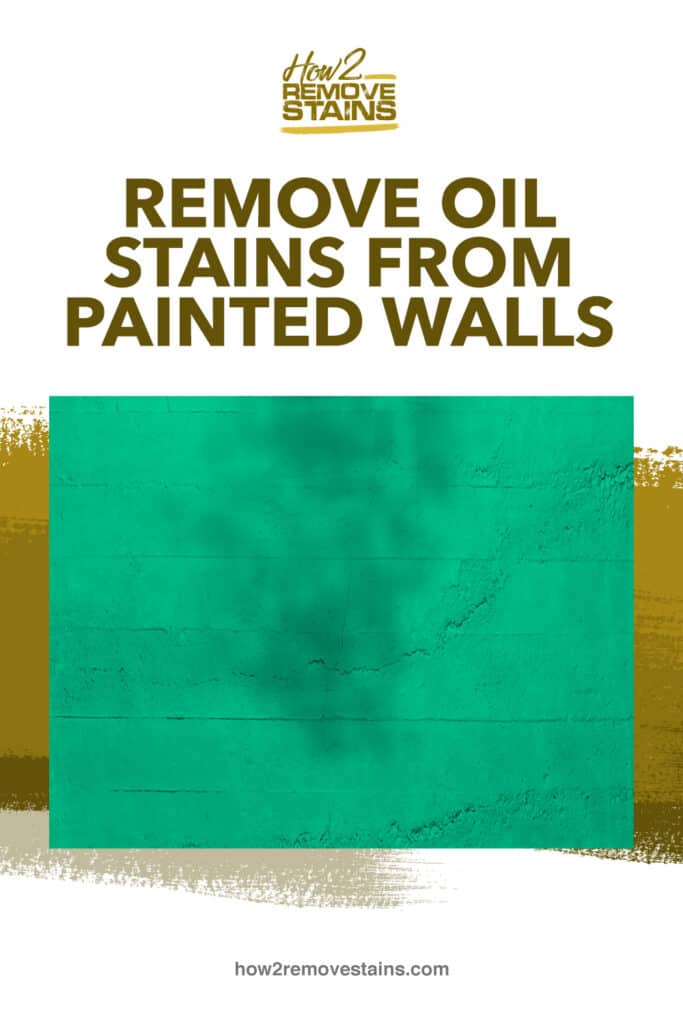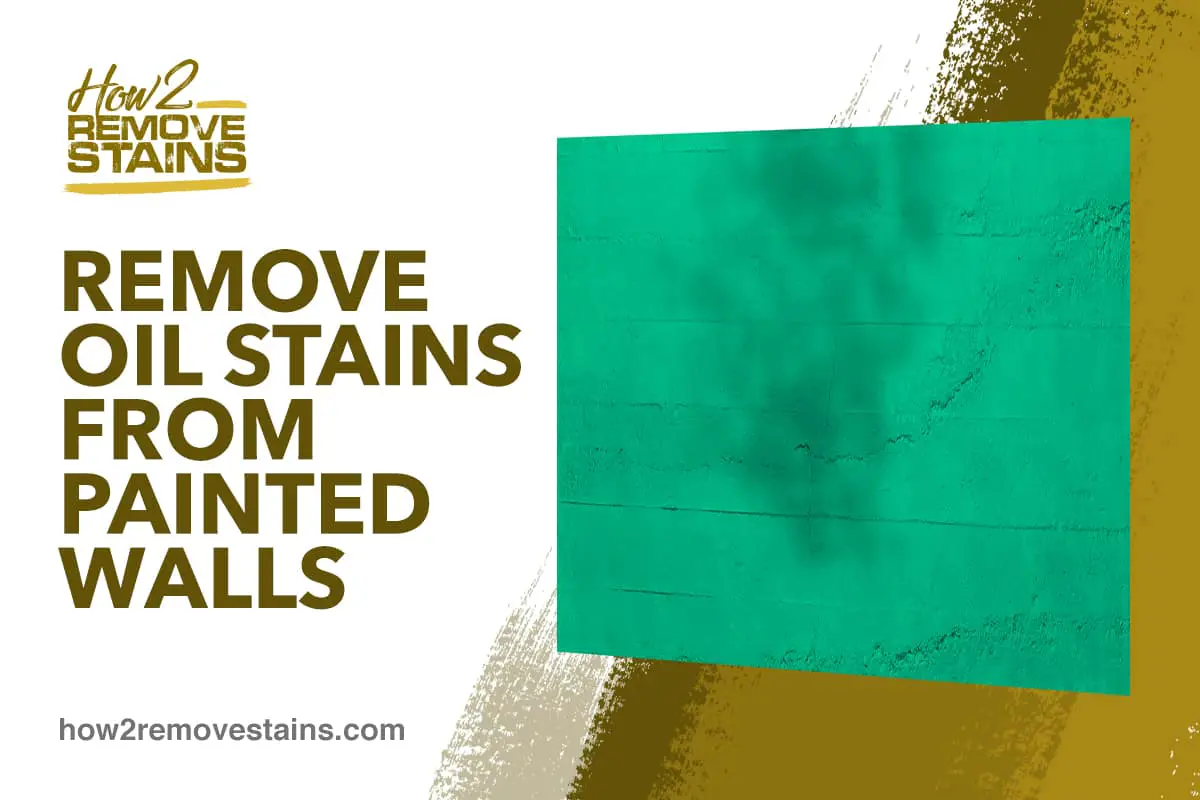When cooking at home, you often deal with oil splatters that can leave oil stains on your wall’s paint, ruining its overall appearance. Luckily, you can deal with these stains using vinegar, regular dish soap, baking soda, or even heat from an iron.
It’s important you get rid of these oil stains as soon as you see them, or they can be difficult to remove later.
If your walls are painted with semi-gloss paint, it will be easier to deal with the stains. Unfortunately, oil stains can be hard to remove from walls with a flat finish or on unfinished wood paneling. In these cases, the best option is often to touch-up the paint.
Read on to learn the different ways to get rid of oil stains on wall paint.
Table of Contents
Techniques for removing oil stains on wall paint
Several cleaners are specially formulated to get rid of oil stains. If you don’t have one, you can use some household products you probably already have at home.
White vinegar: a natural remedy
When you accidentally splash oil on your wall while cooking, it can leave unsightly oil stains and substantially damage your paint job. One way to deal with oil stains on your painted kitchen walls is by using vinegar. Luckily, you can probably find some in your kitchen as well.
White vinegar is known for its acidic property, which works by breaking down the oil and grease, making it the perfect solution for dealing with kitchen stains.
Here’s the step-by-step procedure on how to remove oil stains from the paint on your wall using vinegar.
- If the oil stain is fresh, grab a paper towel and blot as much oil from the wall as possible.
- Soak a sponge or a clean, non-abrasive cloth into the vinegar and apply it directly to the stained area.
- Leave it for 3 to 5 minutes to allow the vinegar to penetrate the stain for easier removal.
- After the allotted time, use the same cloth to gently rub the oil stain. Avoid applying too much pressure on the stain because it could damage the paint.
- When the oil stain visibly lightens, grab another clean cloth and dampen it with clean water.
- Wipe the wall to remove the leftover vinegar residue.
- Finish by wiping the area with a clean, dry cloth.
Using regular dish soap to treat oil stains
Dish soap is remarkably effective in cleaning dishes and oily pots and pans. Considering this, it will undoubtedly get rid of these greasy oil stains from your painted wall as well. Dish soap contains surfactants that allow it to break down oils easily. It is also gentle enough on your paint to not cause any damage.
Follow these easy steps:
- Use a paper towel to soak up as much oil from your wall as possible.
- Mix 1 tablespoon of dish soap with 1 cup of warm water in a mixing bowl. Warm water helps to loosen the oil from the wall.
- Dip a clean cloth or sponge into the solution.
- Scrub the stained area gently until the stain visibly lightens.
- Dampen a clean cloth with clean water and use it to wipe the dish soap residue from your wall.
- Use another clean cloth to dry your oil stain-free wall.
Get rid of oil stains with baking soda
Getting rid of old and dry oil stains from your kitchen walls can be challenging, but with the help of baking soda, the stubborn oil stain will magically vanish. The alkali property of baking soda allows it to simply cut through oil stains and other dirt deposits on your wall.
This natural stain remover is one of the most convenient cleaners because you can find it in most household kitchens and it’s available in almost all grocery stores in your neighborhood.
Here’s how you can do this method:
- Mix 3 tablespoons of baking soda and a cup of warm water to achieve a paste-like consistency.
- Spread your DIY paste cleaner over the stained area. Let it soak for 5 to 10 minutes, depending on the stain’s severity.
- Use a nylon scrubber sponge to scrub the baking soda paste into the stain gently. This will help the baking soda to penetrate the stain on your wall for easier removal.
- Once you get rid of the oil stain, rinse the treated area with clean water using a damp clean cloth.
- After you remove the baking soda and oil stain’s residue, dry your wall with a clean, dry cloth.
A heat treatment to remove oil stains on walls with flat paint
Sometimes attempts at getting rid of oil stains on flat paint result in leaving behind a worse stain than the one you were trying to remove. The best way to avoid this is to treat the stain with heat. Using heat to remove stains may be new to you, but this method is pretty effective.
Follow these steps to remove stains using heat.
- Set your clothes iron to its lowest heat setting and preheat it for a few minutes.
- Hold an absorbent cloth against the stained area and then rub the iron on the cloth using the other hand. Be careful with your hand while rubbing the iron against the cloth to avoid getting burned.
- This method will heat the oil stain from the wall and dissolve the stain eventually while the cloth absorbs the oil stain simultaneously. Make sure not to rub the iron directly on the wall.
- Repeat the process until there’s no oil stain left.
- Once the oil stain is no longer visible, wash your wall with soap and water.
- Rinse it using a damp cloth and dry with paper towels.
[crp]
Common questions about oil stains
Does alcohol remove oil stains?
Alcohol can also be a multi-purpose cleaner, helping to disinfect and remove oil stains. You can use rubbing alcohol to remove oil stains by gently scrubbing it on the stained area using a clean cloth until the stain visibly lightens. Follow by washing the area with detergent and water to make sure there are no oil stains or alcohol residue left on the area.
Can hand sanitizer remove oil stains?
If you get an oil stain on your clothes while you’re outside, let’s say in a restaurant, then hand sanitizer may come in handy for removing the oil stain from your garment. Alcohol-based hand sanitizers can cut through grease and oil stains on your clothes. Just apply it directly to the stained area, let it sit for a few minutes, and rinse and dry in the bathroom.
Does vinegar remove oil?
The buildup of grease on the countertop or stovetop can be a burdensome task to remove unless the right cleaner is used. Fortunately, simply using vinegar is highly effective on grease.
Remember that vinegar should only be used on non-porous surfaces such as glass, metal, or sealed countertops. All you have to do is soak a rag or sponge in vinegar and wipe on the greasy surface. Vinegar’s acetic acid cuts through the grease and grime.
You can also dilute vinegar if the scent is too strong for you. Prepare a solution with 1-part vinegar and 2-parts water. You can include a few drops of essential oils or lemon juice so that it will have a better scent.
How do you remove oil stains with cornstarch?
You can also use cornstarch or flour to get rid of oil stains. Create a paste by mixing with water and apply it to the stain. Leave it in place for several minutes and wipe it away using a moist cloth. Repeat the application, as necessary.
How do you clean cooking grease off your wall?
When cooking grease accidentally splatters on your wall, it is vital to remove them immediately. An effective approach in cleaning cooking grease is using vinegar.
- Simply combine 1-part white vinegar with 1-part hot water. Transfer to a spray bottle and spritz on the grease.
- Leave it in place for several minutes.
- Wipe the site with a clean cloth or rag.
Work in small sections and repeat as necessary to get rid of the cooking grease from the wall.
Can you paint over grease stains on walls?
Regular indoor house paint won’t work on grease stains. No matter how much you want to cover the stain, it will always reappear. So, before adding a new coat of paint, you should get rid of the grease stains on your wall as best as you can.
If you cannot thoroughly remove oil stains on the wall with cleaners or heat, then your only option is to freshen up the paint.
It’s very important to remember that you’ll need to use a stain-blocking primer to stop the oil from seeping through the new paint. Apply a primer that will seal any residue remaining from the grease stain before you paint the wall.
You will probably need to apply a single coat of paint to the entire wall or at least a section enclosed by discrete borders, so he freshly painted area doesn’t stand out.
If you end up with oil stains on your carpet, here are some tips for getting rid of them.
Final thoughts
Wall paint is a major contributor to your home’s aesthetics, and you don’t want these dark, ugly oil stains to ruin it. Fortunately, you can always rely on these straightforward and effective oil stain removing methods to restore the beauty of your wall’s paint keep your walls clean and free from stains.


